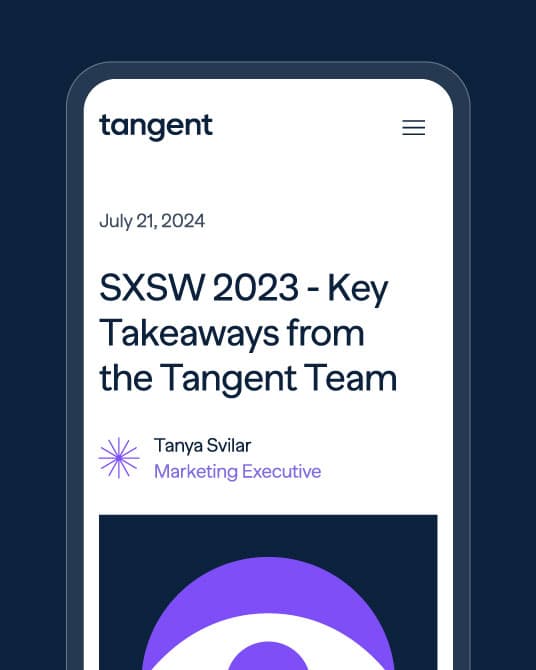
Marketing works hard to drive people to your site. But how do you keep them there?
There are five tiny but fatal flaws that can instantly send visitors packing – and your bounce rate sky-high.
Imagine there’s been a horrendous storm, there are fallen trees everywhere, and the power is down.
You use your phone to Google who to call and what to do next. One site takes you to a long article full of obvious tips like unplugging your TV. The next link is to a company that turns out isn’t in your area. Another is hard to use on mobile, and when you find a link to a ‘postcode checker’ - it goes nowhere.
Frustrating, right? And we’ve all been there! These are precisely the scenarios that lead to a high ‘bounce rate’ – visitors leaving sites instantly and without taking any action. So if your site has a high bounce rate, it might indicate that you’re not meeting user’s needs or there may be some serious issues you need to address.
But that’s not always the case.
Is a high bounce rate always a bad thing?
What your ‘bounce rate’ actually refers to is the proportion of visitors that leave your website without making any requests to navigate to other pages. In other words, bounce rate reflects the number of single page versus multiple page views.
Now, if your site mainly offers information, then this may not be a bad thing. It might indicate people are finding what they’re looking for on each page and need not look further. Likewise, contact pages can have high bounce rates because visitors look up your address and instantly leave.
However, most of the time, a high bounce rate isn’t what you want.
Why? Because as we all know, visitors don’t want to have to scroll down through one huge page that contains all your business information. Websites aren’t designed in that way. Content is instead organised into separate sections – for example, homepage, about us, products, services, contact, etc. No one page provides all the necessary information. We need visitors to move from page to page.
If they’re viewing just one page then leaving, we know they’re not progressing on their journey.
Bounce rate can be an important metric for determining whether your site is engaging your visitors. But it can do more than that; it can have an impact on your SEO too. While bounce rate itself isn’t considered to be a Google ranking factor, many of the things that can cause a high bounce rate are. By understanding why people are leaving, you may notice your search rankings begin to rise.
Is your bounce rate too high?
You should be able to find your bounce rate in all standard analytics tools. In Google Analytics, you can find this under ‘Audience Reports’.
As a rule of thumb, if your bounce rate is anywhere north of 56%, you should take urgent action. 40-55% is better, but you should be aiming for less than 40%. Anything less than 26%, and you’re definitely on the right track.
What’s really to blame for your bounce rate?
If your bounce rate is higher than where you want it to be, you need to figure out what’s going wrong.
Of course, every business is different. But at Tangent, we tend to see a few common causes of high bounce rates crop up time and time again. Here are the five worst offenders.
1. Slow Load times
Clicking through to a website and then sitting there for ages while it attempts to load is one of life’s less pleasant experiences. It’s no surprise that most people won’t wait around.
According to Google, it takes only seconds for a visitor to get fed up.
Google research shows that:
A 2-second delay from 1-3 seconds boosts page bounce rate by 32% A 4-second delay from 1-5 seconds boosts page bounce rate by 90% A 5-second delay from 1-6 seconds boosts page bounce rate by 106% A 9-second delay from 1-10 seconds boosts page bounce rate by 123%
Solution: Try to reduce the amount of work that your website has to do to load. Think about compressing images, caching your site and minifying your HTML to lessen the load – quite literally.
2. Poor mobile optimisation
More than half of all web traffic today comes from mobile devices, which means that if you haven’t yet optimised your site for mobile, you could be losing out on a significant pool of potential customers.
In fact, Google suggests that visitors are 5 times more likely to leave a site if it’s not mobile-friendly.
While it’s not a quick fix, optimising for mobile is non-negotiable these days, particularly for digital products.
Solution: There are two options. One: make your existing website responsive. Two: develop a mobile version or app for phones and tablets.
3. Confusing layout or design
First impressions count. In fact, it’s said that visitors judge a website in less than two-tenths of a second - particularly on its design.
Reports show that 42% of visitors will leave a website if the functionality is poor. When questioned, more than a third of web designers said that an outdated design was a top reason for high bounce rates.
And it makes sense, doesn’t it? Imagine you land on a page that looks awful, or a page that you literally have no idea how to move on from. You’re not going to trust that site or that organisation and certainly not going to buy from them.
Solution: If navigation is the problem, organise your content better so every next step feels intuitive. Otherwise, you might want to start looking into a full redesign for optimum results.
4. Broken links
Imagine you search for something and Google directs you to a relevant web page. That page is perfect. It’s got the content you were looking for, and it’s answered some of your questions. And for those questions where you just need a little extra detail, there are links to internal and external resources to help you.
Fantastic.
Now imagine that clicking those links does absolutely nothing. They’re dead. They don’t trigger a request. Most of us won’t go to the effort to find that missing content, we’ll go back to Google instead.
Solution: Run regular audits and immediately replace, redirect or remove broken links as soon as you find them.
5. Irrelevant content
Finally, we can’t talk about bounce rate without talking about content.
‘Content is king’, as the saying goes. And when it comes to keeping people on your sites and encouraging them to take action, your content is the tool that will help you achieve that.
When visitors are directed to a web page through a search engine, they will already have a preconceived idea of the type of content they’re going to see. Maybe they’ve searched for ‘COVID safety infographic’, and your page has ranked for those keywords. If a visitor then arrives at the page and finds a long block of text with no infographic to be found – they’re going to be pretty confused. Quite simply, it’s not the content they wanted, so there’s no point sticking around.
Solution: Prioritise your content and your SEO efforts. Make sure you’re creating clear and relevant content and that you’re using the right keywords to match pages with relevant user searches.
No bouncing
At Tangent, our area of expertise lies in helping businesses maximise the value of their digital products from every angle – through design, research, optimisation and enhanced user experience.
Need help lowering your bounce rate? Our cross-disciplinary teams can help to elevate your product by helping you understand what your users are looking for, tackling common vulnerabilities and helping you meet your digital ambitions.


















